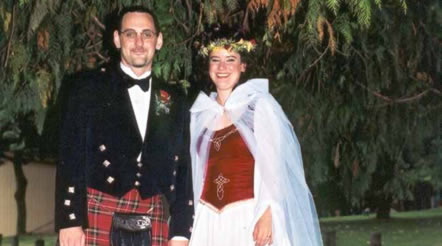
|
| Scottish
Wedding Culture and Traditions A tub of water was placed in the best room, in which the bride placed her feet, her female friends then gathered around to help wash them. A wedding ring from a happily married woman was previously placed in the tub and it was believed that whoever found the ring would be the next to get married. The men folk were outside the door making jokes and attempting to watch through the doorway. The bridegroom was then seized by the women and made to sit at the tub. His legs were none too gently daubed with soot, ashes and cinders - quite a painful procedure! Scottish Wedding Photography, Scottish Wedding Traditions, Scottish Wedding Styles, Scottish Wedding Cultures Scottish Wedding Traditions, Scottish Wedding Styles, Scottish Wedding Cultures. The Wedding Procession The following day the bridal party made their way to the church, flower petals being thrown in front of the bride, but if they encountered a funeral or a pig on the way, it was considered bad luck and they would return home and set out again. The first person they encountered was called the first foot and would be given a coin and a drink of whisky by the bride. He would then have to accompany the bridal party for one mile before being allowed to continue on his way. The Church The Celebrations The guests returned to a relative's home to share the food and drink. The celebrations were usually held outside with pipers and dancing and could last all night. A traditional reel was led by the newly weds, after which the bride danced with the most prominent person in the room, and then the other guests joined in. The couple was finally escorted to their new home and the groom or groomsmen would throw handfuls of coins on the ground. Before entering her home, oatcakes or bannocks were broken above the bride's head and then shared around. The bride could then be carried over the threshold in case she stumbled - a sign of bad luck. The marriage ceremony was completed when the clergyman blessed the newly weds, their home and their bed. The Highland custom of CREELING THE BRIDEGROOM A large basket or 'creel' was filled with stones and
tied to the bridegroom's back. He then had to carry it around the
entire town unless his bride agreed to kiss him. Only if she did,
would his friends allow him to escape from the 'creeling' otherwise
he had to continue until he had completed the circuit of the town. It was the privilege of the bride to choose the music
for the 'shaim spring', which she danced with the bridegroom maids
and best man. In the eighteenth century the custom of handfasting was observed. A couple would live together for a year and a day, at which time they could decide whether to part or make a lifelong commitment. It was considered more important for the bride to be experienced and fertile than to be a virgin.
|
